

Light Painting Artist Troy Paiva. Light painting photographer Troy Paiva has been capturing night imagery since 1989.
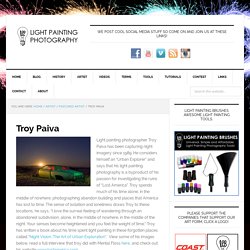
He considers himself an “Urban Explorer” and says that his light painting photography is a byproduct of his passion for investigating the ruins of “Lost America”. Troy spends much of his time alone, in the middle of nowhere, photographing abandon building and places that America has lost to time. The sense of isolation and loneliness draws Troy to these locations, he says, “I love the surreal feeling of wandering through an abandoned subdivision, alone, in the middle of nowhere, in the middle of the night.
Your senses become heightened and you feel the weight of time.” How to Avoid Star Trails by Following the '500 Rule' Long Exposure FAQ. The first in a series of FAQ’s on a variety of topics but always related to Black and White fine art photography.
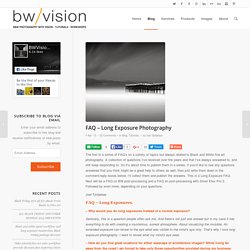
A collection of questions I’ve received over the years and that I’ve always answered to, and still keep responding to. So it’s about time to publish them in a series. If you’d like to see any questions answered that you think might be a great help to others as well, then just write them down in the comment/reply boxes below, I’ll collect them and publish the answers. Airstream Trailer: Light painting. What is Reciprocity Failure?
"Lower Manhattan Glowing" - by Shawn Hoke, via FPP Flickr Pool Whether you’re using a lower speed film in daylight, trying to maximize your depth of field in a landscape, or just setting up the camera for an exposure at night, sooner or later you’re going to start pushing the limits of your film’s light gathering ability.

As light becomes more scarce, the silver halide grains residing in your film will be less uniformly struck by photons, causing a steep drop in density after a few seconds of needed exposure. This exponentially diminishing response to low light levels is more popularly known as a film’s reciprocity failure. Not all films are created equal, and some will respond better than others, but here’s what you can typically expect: B&W Film - exposures in excess 1-2 seconds will result in reduced density, yielding very thin, if not non-existent shadows.
Slide Film - exposures in excess of 5 seconds have color shifts similar to color negative. So how can we avoid the “Effffed!” Night Photography Documentary (part 2 of 3) Free Online YouTube Downloader: Download YouTube Videos, Facebook and many others! Night Photography Documentary (Part 1 of 3) Setting White Balance for Night Photography. Night Photography and White Balance: a quick guide. There are many “auto people” and “auto photographers” in this world… Many of us are relieved that the camera will take the responsibility to find the right exposure, the right focus, even the right shutter speed in regards to the focusing length of your lens.
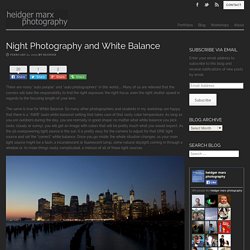
The same is true for White Balance. So many other photographers and students in my workshop are happy that there is a “AWB” (auto white balance) setting that takes care of that nasty color temperature. As long as you are outdoors during the day, you are normally in good shape: no matter what white balance you pick (auto, cloudy or sunny), you will get an image with colors that will be pretty much what you would expect. As the all-overpowering light source is the sun, it is pretty easy for the camera to adjust for that ONE light source and set the “correct” white balance. View of Downtown Manhattan from Brooklyn – early twilight, White Balance: 5500K. Understanding Golden Hour, Blue Hour and Twilights. Behind The Image: David Clapp's moonlight moorland obsession. In a new series of weekend guest blogs on Digital Camera World, professional travel and landscape photographer David Clapp will be sharing the stories behind how he made some of his favourite images.
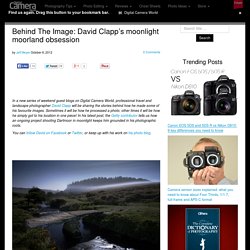
Sometimes it will be how he processed a photo; other times it will be how he simply got to his location in one piece! In his latest post, the Getty contributor tells us how an ongoing project shooting Dartmoor in moonlight keeps him grounded in his photographic roots. You can follow David on Facebook or Twitter, or keep up with his work on his photo blog. Well it doesn’t get more wonderful than this, shooting in moonlight on Dartmoor. Its been an ongoing project for a few years, but this year I plan a return to my photographic roots with some new technology.
It all began four years ago when I locked the car and wandered off into the night. After that first nervous night, the sense of elation I felt walking around the granite Houndtor, is something I will never forget. Cities at night: how to photograph urban areas mixing natural and artificial light. Photographing cities at night can prove challenging for many photographers who struggle to get an accurate exposure.

In this urban night photography tutorial we explain how to mix artificial and natural light for a more balanced shot. When shooting city scenes at night, or more specifically at twilight, there are two sources of light; one from artificial sources such as street lamps and the other from residual natural light. The problem is that if one is brighter than the other, the resulting picture will have some parts that are correctly exposed but other areas that are either very dark (under-exposed) or very bright (over-exposed) depending on how you have taken the meter reading. The solution is to time the taking of your images so that the light levels from these different sources is the same, which will then produce an evenly exposed shot. Night Photography Lesson. Copyright: This lesson MAY NOT be copied to your website or blog, please use the social networking buttons above to link to it.

See our Terms and Conditions. This free lesson assumes the student has some knowledge in practical photography (equivalent to a pass level in our Basic Photography course). If you like what you see in this lesson, but cannot understand all the information given, enrol in our new Creative Photography course and get all the help and encouragement you need! All our courses enjoy tutor assisted learning so you are never left alone wondering what it all means.
Once the sun has set many photographers will pack away their cameras and go home. Throughout our courses we emphasise the importance of light for the photographic image. Metering for low light landscapes – John Patrick Photography Blog. August 26th, 2011 With the late summer nights starting to draw in, my thoughts are turning to planning my first night time photography trips of the autumn season.

Metering for Night Photography. Video Notes: Metering is a subject we haven’t covered in a little while, but after doing some night shooting last week I realized this would be a great subject to cover.

Modern cameras have very advanced metering systems, but I’ve found shooting at night is one of the most difficult things for your camera’s meter to handle. Remember, you camera meter is a computer and its not going to make decisions based on mood, tone or your own taste. Its particularly important to know that you’re eye is you best tool. Check your exposure often and pay careful attention to what kind of a mood, tone, feel and general exposure you are trying to get. Essentials to Getting Started with Low-Light and Night Photography. The following two tabs change content below.
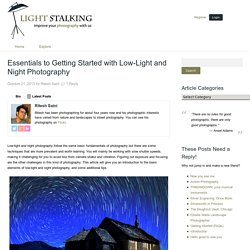
Essentials to Getting Started with Low-Light and Night Photography. Photographing Cityscapes. Capturing Night Signs When photographing signs at night, one of the most important factors is light metering. The combination of a bright sign and a dark background can confuse the camera, leaving you with an under or over exposed image. How To Take Great Photos At Night » Architecture and Landscape Photographer Surrey London. Photographs taken at night can provide a view of place that look spectacular when the night lights are on.
The lights from the streets and buildings provide a unique atmosphere and highlight the subject matter. 20 seconds at F/11, ISO 100. How to Shoot Eye Catching Night Scenes. Written 5 years ago by Mark Evans Looking for inspiration, and spot of photography? Â Well why not try in the middle of the night! Â Ok it may look a little dodgy wandering about with a camera in the dark, but some of the best shots can be had while out and about in the witching hour. Catching Motion Movement is great, especially when the subject has lights on it. Selective Lighting. NIGHTVISION. The Nocturnes - Tips & Tricks. Night Photography - General Information by Tim Baskerville The practice of photographing at night goes back to some of the first photographers.
Technical limitations (slow film speed, large camera size, the large wet plates that were used, etc.) severely hampered efforts in this area of photography. However, from the early 1900's on more and more night photographs can be seen. Stieglitz, Brassai, Genthe, Steichen - all have made some notable images that were nocturnal.